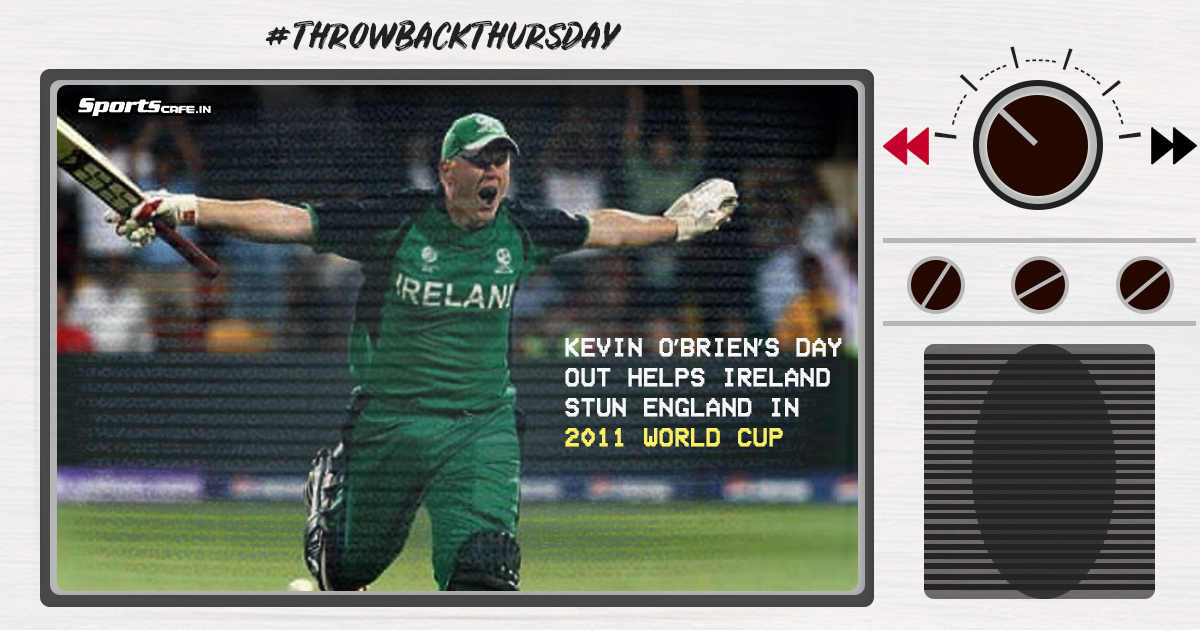Throwback Thursday | Kevin O’Brien’s day out helps Ireland stun England in 2011 World Cup

Kevin O'Brien's century propelled Ireland to victory
|SportsCafe
Welcome to the series where we look at how an event in the past has shaped the way cricket has been seen, in our weekly segment, ‘Throwback Thursday.’ In this week’s episode, we are looking at a cross-country rivalry between England and Ireland but in an event that transpired in India.
It is March 2, 2011, and we are at the Chinnaswamy Stadium in Bengaluru, where the mighty English are facing their neighbours, Ireland, in a World Cup encounter far away from the familiar conditions at home. The neutral supporters have already witnessed plenty of runs, having walked into the stadium knowing this was on cards after England’s domination a few days ago at the same venue. But it was getting late as the crowd were still eagerly ready waiting for witnessing a miracle and the equation was simple - Ireland needed three runs to complete a sensational win. Facing James Anderson for Ireland’s historic moment was John Mooney, their Gaelic hero. Before we get to experience the thrills of the final over, let us roll back to the events that got us here.
"Go across every sport that's played internationally and there has been a rivalry between the Irish and the English." That stands true even till date and the rivalry dates back to 200 years ago when two boxers fought each other and it was seen as the first of fights between the two countries on any sporting front. In terms of team sports, it dates back to 1875, the very foundation of Irish Rugby Football Union that played England, but let’s skip past that to cricket. Never before in cricket’s long history had the two sides faced each other in such a high-pressure intense environment in the sport. In alien conditions, both the sides were sweating to leave a mark, to turn a new page in their historic rivalry.
It was still early days in the competition. However, both sides were coming on the back of contrasting results. England had thought that they had a rather simple draw in the first round, having to face the Netherlands in Nagpur. As it turned out, it ripped open England’s confidence before the men in Blue crawled their way to victory, on the back of their skipper Andrew Strauss’ 83-ball 88. Strauss and England were not done, as they faced a mightier challenge of playing against India in their own den, in Bengaluru. Now this encounter set up a pretty comprehensive backdrop to England’s epic encounter against Ireland.
The rules were set and the Moneyball was set rolling as India elected to bat first at the Chinnaswamy stadium, one that is widely regarded as one of the best batting tracks in the country. However, on the day, the encounter was far more complex, with turns more obvious and visible than the roads that surrounded the venue in Bengaluru. The English bowlers, in specific, looked like a bunch of ‘hit and go’ bowlers, especially James Anderson who conceded 91 runs in his ten-over spell but Tim Bresnan picked up a fifer to give them the ray of hope.
Ireland, on the other hand, headed into the encounter on the back of a disappointment, in a 27-run loss against Bangladesh where their batsmen could not even chase 206. So this was it, Ireland and England, two rivals in unknown territory with both of them having played contrasting cricket. Strauss won the toss on that particular night and elected to bat first, a ploy that the Indians tried and tested before at the same venue to no avail. However, this was no India in front of them, this was an Irish side who were failing to chase a sub-par score in Asian conditions. Remember this, an Irish side who failed to chase a sub-par score. England’s batting left no stone unturned, as the top-order put on an amazing run-fest for the crowd, with Strauss and co having scored 122/2 at the end of the first 20 overs.
Surely it left a stinging effect on the Irish bowlers, who had the toughest task of bowling in the heat during the Indian summer. This was no longer a battle between bowlers and batsmen, it was a battle between bowlers, humidity, dehydration and batsmen. Everything was lopsided in the batsmen’s favour (read: England). As tough as it looked, Ireland in hindsight knew that it was going to get better by the time the sun starts setting. As hot it was in the early parts, dew was going to play a huge factor towards the back-end of the innings and given England’s attack had pacers everywhere, it was going to be an uphill task for the favourites.
Trott trotted his way to 92, as Bell, Pietersen and Strauss around him managed to up the ante. Mooney was the most impressive of all, picking up four-fer in the innings, but still England toppled Irish bowlers to score 327/8, 11 shy of what they managed to achieve against India a few days ago. For Ireland, this game seemed done even before their chase started, looking at the total on board. But as it stood, conditions became more favourable and batting became friendly. But didn’t they lose a wicket early on?
Early in the innings, rather the first ball, skipper William Porterfield was back to the hut as the English fans started pumping-up, knowing that two points were around the corner. Familiar faces, Ed Joyce and Paul Stirling, started lighting the match up with some breathless cricket. But the question was not can they, it was will they? When Stirling was dismissed, there was still a ray of hope. But all of it, the fans, the rather hopeful Irish batsmen, all turned into a sad and immersive face when they were reduced to 111/5. The game looked done as the crowd were left dejected because of an expected early finish.
Kevin O’Brien did what was needed to pump in something for the game and for the fans, an array of shots inducing entertainment. The crowd forgot where they were and which format the game was, thanks to a T20-esque innings from the all-rounder. He spared none, none whatsoever on the night as he batted with an iron-clad. At the other end was Alex Cusack, who averaged in the lower-20s before this encounter and England hoped he didn’t better his own record. A combination of a tuk-tuk Cusack and a monstrous O’Brien that was on display left England frustrated, as the fans were thoroughly entertained by their frustration.
With 56 more runs needed, Cusack had a brain-fade as Mooney joined O’Brien in the middle. After watching a brain-fade from the other end, the all-rounder decided to get involved in another one as 12 runs separated Ireland from a historic victory. So here we are, Mooney and Anderson at either end of the spectrum but only one will stand tall.
Welcome to a moment in history
— faceplatter49 (@faceplatter49) August 6, 2020
